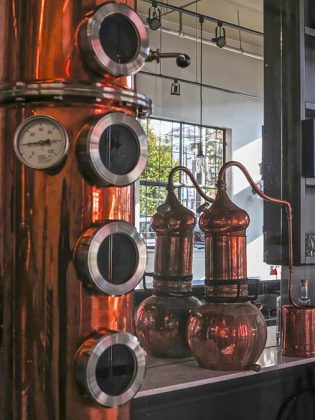At the Italian grocery store near my house I stock up on red, non-alcoholic aperitivos. They taste like fizzy Campari, with the same bitter finish. I drink one with dinner, and am not alone in enjoying an alcohol alternative. The trend for millennials in particular to drink less in favor of health and self-care has been well-documented. Headlines like “Millennials are Sick of Drinking” from The Atlantic, or “The Rise of the Sober Curious: Having it All Without Alcohol” in The Guardian were everywhere last year.
According to data from the beverage market-research firm ISWR, the US market for low and non-alcoholic beverages sold in a ready-to-drink format will grow by about 39% in the next two years. Recently, Molson bought a kombucha company, Heineken and Budweiser have released non-alcoholic beers, and Diageo is investing heavily in non-alcoholic and low-alcohol alternatives.
One completely new product category appeared before the dusts have settled. This is the non-alcoholic distillate, or non-alcoholic spirit. There are dozens of brands in the UK already, but up until now only Seedlip was available in the US. Already local companies are jumping to fill the void. Look for Monday “a gin without the hangover,” Ritual Zero Proof with a whisky, as well as gin, and Lumette “alt-gin.” With a survey of the brands in production and set to arrive this year, though the method is often veiled in secrecy, it seems non-alcoholic spirits are made with hydrosols, or water distillates, for flavor.
Are non-alcoholic distillates a distiller’s terrain? Many of the new brands have been created by entrepreneurs rather than distillers. Ben Branson of Seedlip belongs to this camp, with a background in farming rather than spirit-making. Monday from California was created by “gin-enthusiasts.” Ritual Zero Proof was developed by a group of “passionate foodies and damned good cooks.” On the other hand the first Canadian offering to the category, Lumette, comes from the team at Sheringham Distillery who in 2019 won World’s Best Contemporary Gin in London for their Seaside Gin.
Expertise with distilling can be applied to make an alcohol alternative. Consider that Seedlip got its inspiration from a book called the Art of Distilling by John French, published back in 1651. French described how to use the distillation method to trap a plant’s essence, with or without alcohol. He often distills with water, oil, or in one recipe with elderberries, even vinegar. Distilling a plant in water, adding more of the herb to the distillate, and repeat eventually produces a liquid “full of the virtue of the vegetable, being almost as strong as a spirit.”
Alcoholic solution has the benefit of being a polar solvent, thus extracting flavors beautifully. It gives the sensation of heat and has a weighty mouthfeel. An interesting problem to think about: How to simulate the properties of alcohol with botanicals, additives and technique?
Both Monday and Ritual Zero Proof claim to mimic alcohol’s tell-tale burn. Alcohol interacts with VR1 receptors in the mouth and throat, triggering a burning sensation. Other compounds that interact with the same receptor include Capsaicin found in hot peppers. Possibly a distillate of habanero might be found in the formula for these non-alcoholic spirits. Mouthfeel is another challenge. The non-alcoholic distillates I have tried have tasted thin without the properties of sugar or alcohol.
Whether this category will last, introducing diversity that people will one day expect, or it will wane is hard to say at this early stage. What is sure for now is that it’s growing and there is room for more craft distillers to join the renaissance of distillation.











